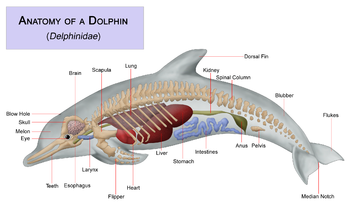
Melon (whale)
Encyclopedia

Toothed whale
The toothed whales form a suborder of the cetaceans, including sperm whales, beaked whales, dolphins, and others. As the name suggests, the suborder is characterized by the presence of teeth rather than the baleen of other whales.-Anatomy:Toothed whales have a single blowhole on the top of the head...
s (odontocetes), including dolphin
Dolphin
Dolphins are marine mammals that are closely related to whales and porpoises. There are almost forty species of dolphin in 17 genera. They vary in size from and , up to and . They are found worldwide, mostly in the shallower seas of the continental shelves, and are carnivores, mostly eating...
s and porpoises (Cranford et al., 1996; Harper, C. J., et al., 2008) and believed to be used in echolocation
Animal echolocation
Echolocation, also called biosonar, is the biological sonar used by several kinds of animals.Echolocating animals emit calls out to the environment and listen to the echoes of those calls that return from various objects near them. They use these echoes to locate and identify the objects...
.
The melon is structurally part of the nasal apparatus (the nose) and comprises most of the mass tissue between the blowhole and the tip of the snout. The function of the melon is not completely understood, but scientists believe it is a bioacoustic component, providing a means of focusing sounds used in echolocation
Animal echolocation
Echolocation, also called biosonar, is the biological sonar used by several kinds of animals.Echolocating animals emit calls out to the environment and listen to the echoes of those calls that return from various objects near them. They use these echoes to locate and identify the objects...
and impedance matching. Impedance matching refers to the melon's function in creating a similarity between characteristics of its tissue and the surrounding water, so acoustic energy can flow out of the head and into the environment with the least loss of energy. Some scientists mistakenly believed the melon functioned in deep diving and buoyancy. These ideas have been discounted over the last 40 years, and are no longer considered valid by cetologists (Cranford, 1999).
Melon size is unrelated to maximum dive depth in toothed whales. The particular characteristics of the melon probably have more to do with odontocete phylogeny, the taxonomic relationships over evolutionary time. In some species, melons are more specialized than others. The sperm whale
Sperm Whale
The sperm whale, Physeter macrocephalus, is a marine mammal species, order Cetacea, a toothed whale having the largest brain of any animal. The name comes from the milky-white waxy substance, spermaceti, found in the animal's head. The sperm whale is the only living member of genus Physeter...
has the largest nose of any animal in the world. The bulk of that nose is composed of two large, fatty structures, the spermaceti
Spermaceti
Spermaceti is a wax present in the head cavities of the sperm whale . Originally mistaken for the whales' sperm , spermaceti is created in the spermaceti organ inside the whale's head and connected to its nasal passage...
organ and the junk. The junk is structurally the same as (homologous to) the melon. The melon is not homologous to the spermaceti organ (Cranford et al. 1996; Cranford et al., 2008).
The lipids (fats, oils, and waxes) within the foreheads of odontocetes are chemically distinct (Litchfield, C., et al., 1975; Koopman, H. N., et al., 2003). They have the unusual characteristics that they transmit sounds at different speeds depending upon the chemical composition, and they are toxic to metabolism. It appears as if these specialized lipid structures evolved as components of the bioacoustical machine in toothed whales.
Even though the spermaceti organ of the sperm whale is not the same as the melon, it is noteworthy because the waxy substance within it was prized by the whalers of the 19th century, because it did not get rancid and burned brightly in their lamps and candles.
The melon of the beluga whale is also unique, in that it is capable of large deformations. These changes in shape probably have the effect of changing the size, shape, direction, and frequency composition of the echolocation beam.

